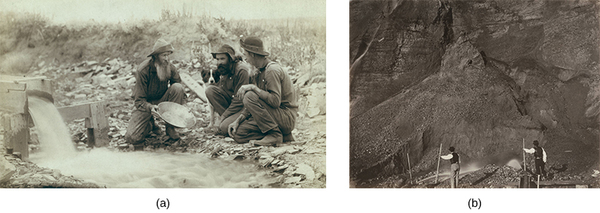| << Chapter < Page | Chapter >> Page > |

By the 1860s and 1870s, however, individual efforts to locate precious metals were less successful. The lowest-hanging fruit had been picked, and now it required investment capital and machinery to dig mine shafts that could reach remaining ore. With a much larger investment, miners needed a larger strike to be successful. This shift led to larger businesses underwriting mining operations, which eventually led to the development of greater urban stability and infrastructure. Denver, Colorado, was one of several cities that became permanent settlements, as businesses sought a stable environment to use as a base for their mining ventures.
For miners who had not yet struck it rich, this development was not a good one. They were now paid a daily or weekly wage to work underground in very dangerous conditions. They worked in shafts where the temperature could rise to above one hundred degrees Fahrenheit, and where poor ventilation might lead to long-term lung disease. They coped with shaft fires, dynamite explosions, and frequent cave-ins. By some historical accounts, close to eight thousand miners died on the frontier during this period, with over three times that number suffering crippling injuries. Some miners organized into unions and led strikes for better conditions, but these efforts were usually crushed by state militias.
Eventually, as the ore dried up, most mining towns turned into ghost towns. Even today, a visit through the American West shows old saloons and storefronts, abandoned as the residents moved on to their next shot at riches. The true lasting impact of the early mining efforts was the resulting desire of the U.S. government to bring law and order to the “Wild West” in order to more efficiently extract natural resources and encourage stable growth in the region. As more Americans moved to the region to seek permanent settlement, as opposed to brief speculative ventures, they also sought the safety and support that government order could bring. Nevada was admitted to the Union as a state in 1864, with Colorado following in 1876, then North Dakota, South Dakota, Montana, and Washington in 1889; and Idaho and Wyoming in 1890.
While the cattle industry lacked the romance of the Gold Rush, the role it played in western expansion should not be underestimated. For centuries, wild cattle roamed the Spanish borderlands. At the end of the Civil War, as many as five million longhorn steers could be found along the Texas frontier, yet few settlers had capitalized on the opportunity to claim them, due to the difficulty of transporting them to eastern markets. The completion of the first transcontinental railroad and subsequent railroad lines changed the game dramatically. Cattle ranchers and eastern businessmen realized that it was profitable to round up the wild steers and transport them by rail to be sold in the East for as much as thirty to fifty dollars per head. These ranchers and businessmen began the rampant speculation in the cattle industry that made, and lost, many fortunes.

Notification Switch
Would you like to follow the 'U.s. history' conversation and receive update notifications?